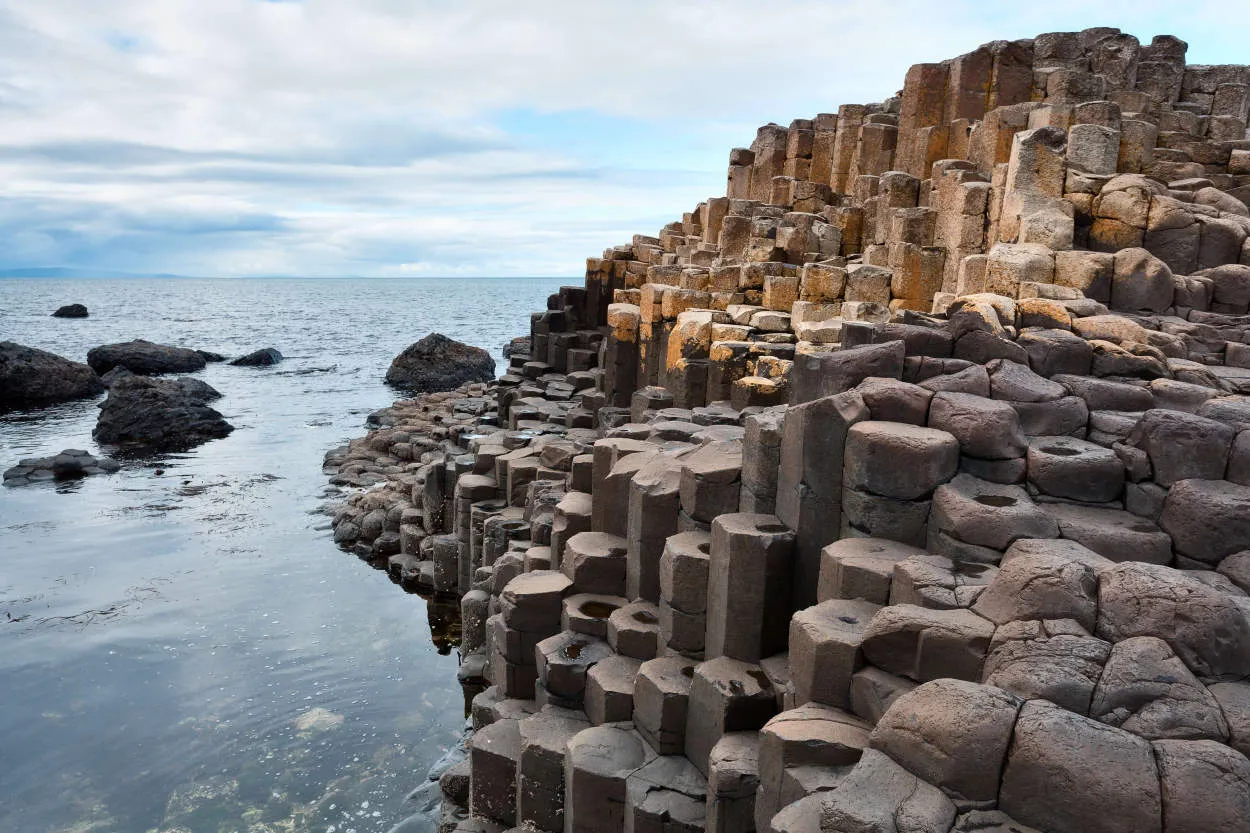The Giant’s Causeway, located in Northern Ireland, is a remarkable natural wonder that has captivated visitors for centuries. With its unique basalt columns formed from ancient volcanic activity, this UNESCO World Heritage Site offers a breathtaking landscape and fascinating geological history to explore.
The Enigmatic Hexagonal Stones of the Giant’s Causeway
The Giant’s Causeway, located in Northern Ireland, is a remarkable natural wonder that has fascinated visitors for centuries. At the heart of this famous site lies a geological marvel – the enigmatic hexagonal stones.
The hexagonal stones of the Giant’s Causeway are a result of ancient volcanic activity that took place over 50 million years ago. As molten lava cooled rapidly upon coming into contact with the cold sea water, it solidified and formed these unique polygonal columns.
What makes these stones even more intriguing is their near-perfect shape and interlocking pattern. The precision with which they fit together has amazed scientists and inspired countless legends and myths. The columns range in size and can reach heights of up to 12 meters.
Visitors to the Giant’s Causeway are often left in awe of the symmetrical beauty and mystique surrounding these stones. Exploring the interlocking pathways formed by these hexagonal columns is akin to stepping into another world, where nature’s handiwork truly captivates the imagination.
Today, the Giant’s Causeway is a UNESCO World Heritage site and attracts tourists from all corners of the globe. It serves as a testament to the Earth’s geological history and reminds us of the extraordinary forces that have shaped our planet over millions of years.
Legends and Folklore: Exploring the Mysteries of the Giant’s Causeway
The Giant’s Causeway is a mesmerizing natural wonder located in Northern Ireland. It is a UNESCO World Heritage site that attracts visitors from all around the world. The unique geological formations of the causeway have given rise to fascinating legends and folklore.
According to an old Irish tale, the causeway was built by the giant Fionn mac Cumhaill (also known as Finn McCool). Fionn, who was renowned for his extraordinary strength, constructed the causeway as a pathway to reach his Scottish rival Benandonner. The hexagonal basalt columns that make up the causeway are believed to be the remains of this mythical construction.
Scientifically, the Giant’s Causeway was formed around 60 million years ago during intense volcanic activity. Molten basalt lava rapidly cooled and contracted, leading to the formation of the distinctive hexagonal columns. The back-and-forth movement of geological forces and erosion over millions of years sculpted the causeway into its current magnificent state.
Visitors to the Giant’s Causeway can explore the area through various trails and enjoy breathtaking views of the surrounding cliffs and the wild Atlantic Ocean. The site offers a visitor center that provides extensive information about its geological significance and the legends associated with it.
Legend has it that Fionn’s creation, the causeway, stretches underwater all the way to Scotland, forming a bridge between the two countries. This mythical bridge is said to have allowed Fionn and Benandonner to confront each other in a legendary battle. Today, only remnants of the causeway are visible above sea level.
Whether one believes in the folklore or appreciates the geological marvel, the Giant’s Causeway continues to captivate and inspire awe in its visitors. It stands as a testament to the forces of nature and the rich tapestry of legends and myths woven into the history of Northern Ireland.
Coastal Wonders and Breathtaking Views at the Giant’s Causeway
The Giant’s Causeway is an extraordinary natural wonder located along the dramatic coastline of Northern Ireland. It consists of about 40,000 interlocking hexagonal basalt columns, stunningly formed by ancient volcanic activity.
Visitors are greeted by a mesmerizing landscape that looks like it’s straight out of a fantasy book. The tall cliffs and the crashing waves of the Atlantic Ocean add to the awe-inspiring beauty of this UNESCO World Heritage Site.
One of the most fascinating aspects of the Giant’s Causeway is its unique geological formations. These hexagonal columns were formed around 60 million years ago due to intense volcanic eruptions. Interestingly, the shapes and sizes of the columns vary, creating a visually captivating sight.
Legend has it that the Giant’s Causeway was created by a mythological giant named Finn McCool. According to the story, he built the causeway to confront a rival giant in Scotland. The true origin, however, lies in the natural wonder of geological processes.
Exploring the area allows visitors to witness not only the stunning columns but also other beautiful features such as the Giant’s Boot, the Wishing Chair, and the Organ. These intriguing rock formations further add to the allure of the Giant’s Causeway.
Aside from the geological wonders, the Giant’s Causeway offers breathtaking views of the North Antrim Coastline. The crashing waves against the rocks and the panoramic vistas create a sense of tranquility and leave a lasting impression on all who visit.
Whether you are a nature enthusiast, a geology geek, or simply someone who appreciates astounding beauty, the Giant’s Causeway is a destination that should not be missed. It is a place where myths and reality intertwine to create an unforgettable coastal experience.
Conclusion
The Giant’s Causeway in Northern Ireland stands as a remarkable and awe-inspiring natural wonder. Its unique formation of hexagonal basalt columns, carved by volcanic activity millions of years ago, is a testament to the extraordinary forces of nature. Visitors from all over the world marvel at the beauty and grandeur of this UNESCO World Heritage site, making it a must-see destination for nature enthusiasts and adventure seekers alike.




